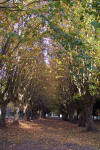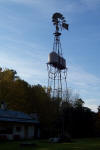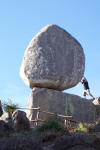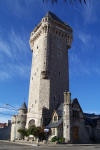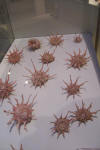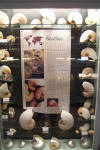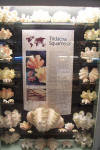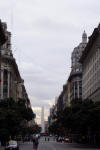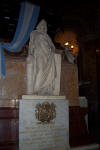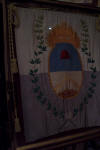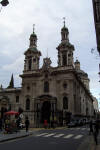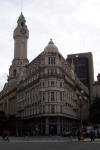Diary/Photo Journal
Week of May 01, 2005
We left Carmen de Patagones a bit disappointed as the city was touted to be more than it was; however, we were delighted to take a slight detour to visit a "big town" or "small city" located away from the coast. Tandil is located at the base of the Sierras de Tandil and is surrounded by spectacular pastureland and farms. What we found were tree-lined streets, friendly people and a great place for a family vacation. They have horseback riding, mountain-bike riding, swimming, hiking, rock climbing, paragliding - you name it, it is all here.
We found a terrific camp just on the outside of town and decided to take a gander at this supposed rather large boulder balancing on a ledge overlooking the city. Thinking that the pictures we saw in town were a bit "edited", we were happily surprised to see Al Centinela to be much bigger than we imagined. Inspecting this rock gave us the opportunity to hike around the upper hill country and having a glorious Fall day only added to our pleasure.
Because of the time spent on nurturing Cindy, we have found ourselves in a bit of a time crunch so we could not linger too long in Tandil. We cruised back to the coast to Mar del Plata and arrived just in time for a great lunch. Having eaten too much gave us the excuse to walk about 10km along the beach and around the well-kept neighborhoods of this summer playground for Buenos Aires residents. Over a million "portenos" (as they call the residents of Buenos Aires - because they live on Puerto Buenos Aires) flock to Mar del Plata for all the amenities the beach can offer. Unfortunately, that means that the beach is dominated by skyscraping monolithic apartments and is in ugly contrast with the beautiful coastline.
Many years ago, Argentina was basking in the glow of a flourishing economy and people found themselves becoming very wealthy. As a result, many of this newfound wealth met with Mar del Plata in the form of large estates/mansions being built overlooking the ocean. But, as we know, a few years ago Argentina's economy was devastated and as a result, much of the new wealth became old bankruptcies. Many of those same homes were abandoned, sold or are still trying to be sold, or converted to apartments or restaurants.
   |
Grave examples of the crash of the
Argentinean economy - substantial homes/mansions left to rot, to be sold or to be converted to apartments or restaurants. |
During our self-guided tour of the city, we stumbled upon a fantastic museum - the Museo Del Mar. This museo is the result of one man's compilation of sea shells that expanded to a museum-worthy collection of over 30,000 shells from around the world. At first, you are amazed by the variety of shells handsomely displayed in individual and well-lighted cases. Then, you start to get dizzily overwhelmed with the sheer number of shells. Finally, you find yourself blinking your eyes to focus of the subtleties of color, texture, shape, size and intricacies of each shell that was once a living animal. We have been to many museums on this journey and we have never seen anything like this. Very remarkable indeed!
We kept moving up the coast and took brief stops in Pinamar and San Clemente del Tuyu. With Buenos Aires in our sights, we did not linger much more along the coast and blended into the mass of metal moving through and around Buenos Aires.
Buenos Aires is home to over 13 million people, taking in the extensive surrounding suburbs. We found the city very welcoming and rather easy to negotiate. For a city with many people, we maneuvered the streets with no difficulty. For a city that is cluttered, we found that it is not dirty. For a city that has a tremendous number of cars, we saw no accidents. Buenos Aires truly is a city that maintains that vital, precarious balance of being a huge city while cherishing its character.
We found a great place for Cindy's well-earned rest and we were able to stay nearby in the Hotel Aires Express. With free breakfast, free internet access and most importantly, full cable TV (which means lots of futbol games), we were set for our stay in the city. Not wanting to waste time, we spent our first day riding the "subte" (subway) and walking all around the "microcenter" of Buenos Aires. From the Presidential Palace (Casa Rosada) to the Teatro Colon to the Palacio Congresso to the various churches, we walked and walked and never tired of the magnificent architecture or being among the lively residents.
Buenos Aires, and Argentina in general, have achieved theatric fame for their association with Evita Peron, second wife of President Juan Domingo Peron (1895-1974). "Don't cry for me Argentina" Evita Duarte Peron (1919 - 1952) was a one-time radio and television actress that used her charismatic influence to charm the "descamisados" (shirtless ones) to the vexation of the established elite. She championed social programs that are still in effect today and for many of the Buenos Aires' elite, her burial at the exceedingly exclusive Recoleta cemetery, is still an abomination.
Now, for a little digression...Argentines are known for their large egos and sometimes their arrogance. Well, as we have found out, they are also the first to make fun of themselves. Here is a joke told to us by Sabrina, a very nice young lady at the Automovil Club of Argentina (like the AAA in the United States).
"How do you make a lot of money?" "Buy an Argentine for what he is worth and sell him for what he thinks he is worth."
And another joke that I gleaned from a Lonely Planet guide: "How does an Argentine commit suicide?" "He jumps off his ego."
OK, no more Argentine bashing, at least for now. Our next day found us partaking in a wide range of experiences. From the Cemeterio de la Chacarita to the Jardin Zoologico to the Hippodromo.
We visited the famed Cemeterio de la Chacarita (of slightly less exclusivity than Recoleta - see next week) and walked among a miniature city of massive tombs and marble monoliths. Besides being the keeper of Presidente Peron's family, this cemetery is especially known for another powerful person, albeit rather non-political. This man had so much influence over people that when he died in an airplane crash, several women (one in New York and one in Puerto Rico) tried to commit suicide and unfortunately, one succeeding (in Cuba). This man that swayed thousands and thousands was none other than "El Zorzal Criollo" or the songbird of Buenos Aires and the father of tango, Carlos Gardel.
Though born in France, Carlos Gardel was the epitome of the immigrant porteno. His destitute single mother brought him to Buenos Aires when he was three and he eventually worked at a number of insignificant jobs. While he seemingly had no direction, he would entertain neighbors with his rapturous singing and began a solo performing career in 1917.
Carlos Gardel is credited with creating the tango "cancion" (song) and thrust it out of the Buenos Aires' brothels and tenements and seduced it into the societies of Paris and New York. His crooning voice, his suave demeanor and his subtle charisma made him a success in Latin America. Once radio found his extraordinary talent, the just-developing film industry also discovered Gardel's "appeal" and a film career was born. Unfortunately, Gardel's influence on the big screen was cut short by a tragic plane crash in Colombia in 1935.
Carlos Gardel has been and is being revered much like a saint and the activity on and around his tomb does nothing to dispel this perception. Flowers adorn his life-size statue and as we saw, a fresh flower was tucked into his bronze lapel and cigarette butts lay at his feet as though he just took his last puff. The devoted are known as "gardelianos" and we witnessed a typical reverence to Gardel's memory: a sixtyish man climbed up onto the tomb, tucked in a fresh red carnation into Gardel's lapel, spoke a quiet prayer eye-to-eye with Gardel, kissed the statue, crossed his torso and slowly climbed down from the tomb. We do not know much about the tango and its influence on Latin America; however, witnessing this display brought a clarification of insight to what this man meant to many.
After our solemn visit to the cemetery, we taxied over to the Jardin Zoologico and enjoyed a sunny day with many happily squealing kids among the many well-kept animals. Not being a person that usually likes to see wild animals penned up, I had heard that this was a nice zoo to visit and a pleasant place to see many South American animals not normally exhibited in zoos.
As described, the zoo was quite enjoyable and unlike zoos in the United States, the visitor can get close enough to the animals to really have a good look at and quite the strong whiff of the animals.
We then walked over to the Hippodromo and as always, we enjoyed watching the horses and the people. Even though the horses did not obey our commands to win, we had a great time losing our pesos.
Home Page South America Diary Index Previous Diary page SA Diary page 37
